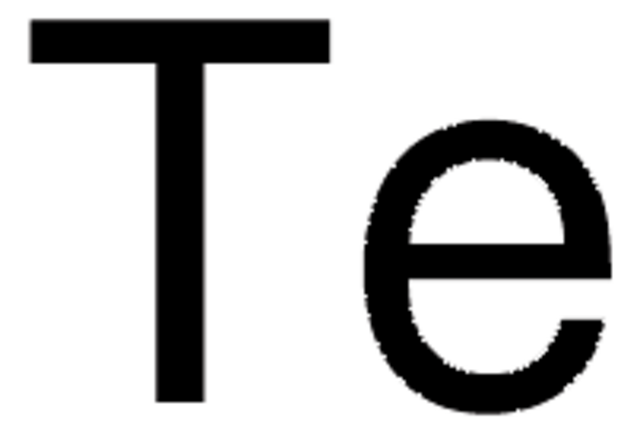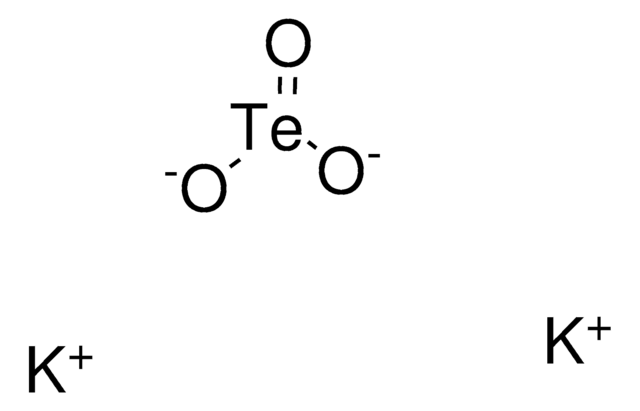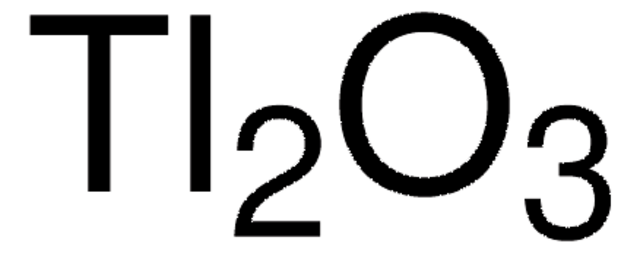243450
Tellurium dioxide
≥99%
Synonym(s):
Tellurium(IV) oxide
Sign Into View Organizational & Contract Pricing
All Photos(2)
About This Item
Linear Formula:
TeO2
CAS Number:
Molecular Weight:
159.60
EC Number:
MDL number:
UNSPSC Code:
12352303
PubChem Substance ID:
NACRES:
NA.23
Recommended Products
Quality Level
Assay
≥99%
form
powder
mp
733 °C (lit.)
density
5.67 g/mL at 25 °C (lit.)
SMILES string
O=[Te]=O
InChI
1S/O2Te/c1-3-2
InChI key
LAJZODKXOMJMPK-UHFFFAOYSA-N
Looking for similar products? Visit Product Comparison Guide
Related Categories
General description
Tellurium dioxide, also known as tellurium(IV) oxide, is a white, crystalline solid with a melting point of 1,130 °C and a boiling point of 1,850 °C. Tellurium dioxide is an important material in a number of applications, including as a catalyst in the synthesis of plastics resins, and pharmaceuticals, and as a component in tellurium-based alloys. Tellurium dioxide is typically made at high temperatures either by decomposition of tellurium(IV) chloride or tellurium(IV) sulfate in the presence of oxygen.
Application
Tellurium dioxide is used to prepare tellurium metal, telluric acid, and many tellurium salts. It may also be used in the preparation of Ag2Te nanoparticles.
Signal Word
Danger
Hazard Statements
Precautionary Statements
Hazard Classifications
Acute Tox. 4 Inhalation - Aquatic Chronic 2 - Lact. - Repr. 1B - Skin Sens. 1B
Storage Class Code
6.1D - Non-combustible acute toxic Cat.3 / toxic hazardous materials or hazardous materials causing chronic effects
WGK
WGK 3
Flash Point(F)
Not applicable
Flash Point(C)
Not applicable
Personal Protective Equipment
dust mask type N95 (US), Eyeshields, Gloves
Choose from one of the most recent versions:
Already Own This Product?
Find documentation for the products that you have recently purchased in the Document Library.
Customers Also Viewed
Mao Shen et al.
Nanoscale research letters, 8(1), 253-253 (2013-05-31)
A facile one-step synthesis of CdTe quantum dots (QDs) in aqueous solution by atmospheric microwave reactor has been developed using 3-mercaptopropionic acid reduction of TeO2 directly. The obtained CdTe QDs were characterized by ultraviolet-visible spectroscopy, fluorescent spectroscopy, X-ray powder diffraction
Tingjun Wu et al.
Frontiers in chemistry, 8, 84-84 (2020-03-21)
A systematic electrochemical study was conducted to investigate the reduction of tellurium (Te) in alkaline solutions. The effect of various parameters, including tellurite ion concentration, applied potential, and pH was investigated by both linear sweep voltammograms (LSVs) and electrochemical quartz
Sankha Chattopadhyay et al.
Applied radiation and isotopes : including data, instrumentation and methods for use in agriculture, industry and medicine, 68(10), 1967-1969 (2010-05-18)
A simple and inexpensive ion-exchange chromatography method for the separation of medically useful no-carrier-added (nca) iodine radionuclides from bulk amounts of irradiated tellurium dioxide (TeO(2)) target was developed and tested using (131)I. The radiochemical separation was performed using a very
Garima Tripathi et al.
Spectrochimica acta. Part A, Molecular and biomolecular spectroscopy, 71(2), 486-489 (2008-03-14)
The energy transfer in Er3+: Sm3+ codoped binary TeO2-Li2O (TLO) glass has been studied using 532 nm laser radiation on the basis of fluorescence intensity and the lifetime measurements. It is observed that the trace of erbium ion can be
G Bilir et al.
Spectrochimica acta. Part A, Molecular and biomolecular spectroscopy, 83(1), 314-321 (2011-09-20)
TeO(2)-CdF(2)-WO(3) glasses with various compositions and Er(3+) concentrations were prepared by conventional melting method. Their optical properties were studied by measuring the absorption, luminescence spectra and the decay patterns at room temperature. From the optical absorption spectra the Judd-Ofelt parameters
Our team of scientists has experience in all areas of research including Life Science, Material Science, Chemical Synthesis, Chromatography, Analytical and many others.
Contact Technical Service











